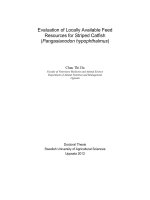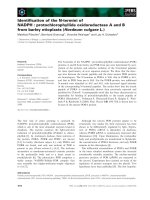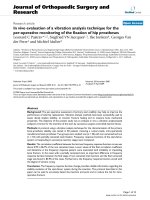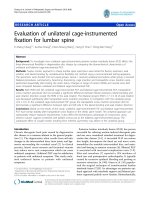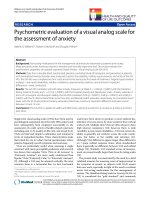Evaluation of exotic germplasm of barley [Hordeum vulgare (L.)] for stability parameters
Bạn đang xem bản rút gọn của tài liệu. Xem và tải ngay bản đầy đủ của tài liệu tại đây (206.56 KB, 8 trang )
Int.J.Curr.Microbiol.App.Sci (2018) 7(7): 1850-1857
International Journal of Current Microbiology and Applied Sciences
ISSN: 2319-7706 Volume 7 Number 07 (2018)
Journal homepage:
Original Research Article
/>
Evaluation of Exotic Germplasm of Barley [Hordeum vulgare (L.)]
for Stability Parameters
Om Vir Singh*, Kartar Singh and Neelam Shekhawat
National Bureau of Plant Genetic Resources, Regional Station, Jodhpur
*Corresponding author
ABSTRACT
Keywords
Barley, Hot arid
climate, Accession
x environment
interaction,
Crossover and noncrossover
interactions,
Regression analysis
Article Info
Accepted:
15 June 2018
Available Online:
10 July 2018
Forty accessions of barley (Hordeum vulgare (L.)) were evaluated during
five Rabi seasons i.e. year 2012-13 to year 2016-17 for eight quantitative
traits and data were subjected to regression analysis and also the analysis to
detect the presence of crossover and non-crossover interactions. Ten
accessions EC 667471, EC 667384, EC 667441, EC 667500, EC 667613,
EC 667550, EC 667603, EC 667567, EC 667369, and EC 667533 were
identified to be promising using regression analysis, whereas nine
accessions EC 667512, EC 667587, EC 667369, EC 667423, EC 667356,
EC 667489 and EC 667533 were identified as potential ones by using
crossover and non-crossover interactions concept. Of these accessions EC
667369 and EC 667533 have been identified as high yielding accessions
having specific adaptability and responsiveness to specific environment
both by regression analysis and crossover and non crossover interactions
concept. However, none of the accessions out yielded any of the used
checks i.e. DL 85, Jyoti and DWR 28 neither by regression nor cross over
and non-cross over interaction analysis.
Introduction
Genotype and environment interaction is the
variation arising from the lack of
correspondence between genetic and nongenetic effects in multi-environment trials.
The different response of genotypes across the
testing environments is considered as a
hindrance in selecting and recommending of
crop varieties and cause yield fluctuations
(Kang, 1988). Genotype x environment
interaction may offer opportunity for selection
and adaptation of genotypes that showed
positive interaction with the specific
environment that help in the effective
utilization of specifically adapted genotype
(Ceccarelli and Grando, 2007). Barley is
cultivated during Rabi seasons in India. To
1850
Int.J.Curr.Microbiol.App.Sci (2018) 7(7): 1850-1857
enhance productivity and production of barley
it is advocated that breeders should look for
the development of stable varieties that should
perform consistently over years and locations.
The present investigation was carried out over
the years during Rabi seasons in the hot- arid
climate of Rajasthan to screen the exotic
germplasm of barley against the local checks
to identify the better replacement of local
checks in terms of yield and other
phonological parameters using regression
analysis (Eberhart and Russell, 1966 and
Perkins and Jinks, 1968) and cross and noncrossover interactions concept (Gail and
Simon, 1985). Earlier information on this
aspect in barley germplasm is not available.
Materials and Methods
Forty diverse exotic accessions received from
abroad also along with best performing local
checks i.e. DL 85, Jyoti and DWR 28 were
evaluated in a randomized block design with
three replications during five Rabi seasons i.e.
from year 2012-13 to year 2016-17 at
Regional Station of National Bureau of Plant
Genetic Resources, Jodhpur. Thus, evaluation
was done broadly in five environments. In
each environment plots consisted of four rows
of 3 m length with row to row distance of 15
cm. Recommended doses of P2O5 @ 30 kg per
ha and N2 @ 60 kg per ha were also applied at
different time of crop growth. Recommended
packages and practices were followed to raise
good crop. The data were recorded on five
randomly taken plants from middle rows of
each plot in each environment on seed yield
per plant (g), biological yield per plant (g),
harvest index (direct values were used for
statistical analysis), number of grains per
spikelet, number of fertile tillers per plant,
plant height (cm.), number of grains per spike
and 1000-seed weight (g) and data were
analyzed separately for each environment.
Adjusted progeny means were used for the
combined analysis and for the traits exhibiting
the presence of g x e interaction. Regression
analysis and analysis to detect the presence of
crossover and non-crossover interactions were
carried out as per Eberhart and Russell (1966),
Perkins and Jinks (1968) and Gail and Simon
(1985).
Results and Discussion
Analysis of variance revealed significant
differences among accessions for the eight
traits in all five seasons. The combined
analysis revealed the presence of g x e
interaction for seed yield per plant (g),
biological yield per plant (g), harvest index
(direct values were used for statistical
analysis), number of grain per spikelet,
(average of 10 randomly taken spikelet from
each plant), number of fertile tillers per plant,
number of grains per spike and 1000-seed
weight (g). Regression analysis enables
breeders to select desirable accessions with
respect to the responsiveness and stability in
different environments. In the studied
materials the accessions EC 667567, EC
667471, EC 667384, EC 667441, EC 667500,
EC 667613, EC 667550, EC 667603, EC
667533, EC 667533 and EC 667369 had
above
average
performance
and
responsiveness with respect to seed yield per
plant using regression analysis (Table 1).
Among these high yielding accessions EC
667567, EC 667471, EC 667384, EC 667441,
EC 667500, EC 667613, EC 667550 and EC
667603 can be designated as stable ones with
average
responsiveness.
Though
the
accessions EC 667533 and EC 667369 are
above average yielder and also have shown
above average responsiveness coupled with
instability. Accession EC 667533 and EC
667369 were highest yielder during Rabi 2013
and Rabi 2014 respectively followed by EC
667533 (Rabi, 2012), EC 667567 (Rabi,
2012), EC 667471, EC 667384, EC 667441,
EC 667500, EC 667613, EC 667550 (Rabi,
2015) and EC 667603(Rabi, 2013). The
1851
Int.J.Curr.Microbiol.App.Sci (2018) 7(7): 1850-1857
accession EC 667533 showed above average
performance along with instability for Seed
yield per plant, biological yield per plant,
1000-seed weight, number of fertile tillers per
plant and plant height (cm.) being the best
performance of this accession for these traits
again in Rabi 2013 and accession EC 667369
showed above average performance along
with instability for seed yield per plant,
biological yield per plant, number of seed per
spike, number of fertile tillers per plant and
plant height (cm.) being the best performance
of this accession for these traits again during
Rabi 2014.
The regression technique describes the
response pattern of individual accession
without differentiating the kind of g x e
interaction involving change in magnitude of
response or direction among the accessions
(Baker, 1988 and Virk and Mangat (1991).
Baker (1988) described a test, which was
initially proposed by Gail and Simon (1985)
and illustrated its application to test the kind
of interaction in crop plants. The concept of
crossover and non-crossover interaction is
important in decision making relating to crop
improvement strategies (Baker, 1988), since
the presence of crossover interaction is
substantial evidence in favour of breeding for
specific adaptation to certain situations. Baker
(1988) further suggested that in the absence of
crossover interaction there is little substance
for argument in the favour of breeding for
adaptation to specific environment. The
accessions exhibiting crossover interaction
against a standard variety can be said to have
specific adaptability and can replace that
standard variety in the specific environments.
The existence of prior scientific basis to
explain crossover interaction is crucial (Peto,
1982). Thus, it is advantageous to define the
varietal combinations among which one has to
look for qualitative interaction in advance.
There will be enormous multiplicity of all
possible varietal pairs for detection of
crossover interaction if there is no prior basis
for comparison. Such a practice will greatly
increase the experiment-wise error rate. In the
present case the new accessions were
therefore, compared with the best check DL
85 for detection of crossover interaction since
the aim was to find a suitable alternative to
DL 85.
The H (heterogeneity of response) and Q+ and
Q- (for the presence of crossover interaction)
against the standard variety DL 85 were
estimated for all the 40 accessions for the
traits exhibiting the presence of g x e
interaction, i.e. seed yield per plant (g),
biological yield per plant (g), harvest index,
plant height, number of seeds per spikelet,
number of fertile tillers per plant, number of
grains per spike and 1000-seed weight (g) and
their significance was tested (Baker, 1984).
The accession exhibiting either significant H
or Q+ and Q- are given in Table 2. For seed
yield per plant H was significant for the 40
accessions against DL 85.
The presence of crossover interaction was
observed for twenty nine accessions namely;
EC 667348, EC 667361, EC 667512, EC
667391, EC 667587, EC 667412, EC 667597,
EC 667464, EC 667369, EC 667423, EC
667575, EC 667356, EC 667427, EC 667380,
EC 667450, EC 667533, EC 667391, EC
667559, EC 667609, EC 667600, EC 667541,
EC 667592, EC 667489, EC 667583, EC
667480, EC 667506, EC 667419, EC 667516,
EC 667527 (29 accessions) for seed yield per
plant against DL 85.
The 38 accessions i.e. EC 667489, EC
667348, EC 667391, EC 667361, EC 667471,
EC 667384, EC 667441, EC 667500, EC
667613, EC 667550, EC 667391, EC 667587,
EC 667603, EC 667412, EC 667436, EC
667567, EC 667533, EC 667464, EC 667369,
EC 667423, EC 667575, EC 667356, EC
1852
Int.J.Curr.Microbiol.App.Sci (2018) 7(7): 1850-1857
667427, EC 667380, EC 667391, EC 667609,
EC 667600, EC 667541, EC 667489, EC
667583, EC 667480, EC 667506, EC 667419,
EC 667516, EC 667550, EC 667391, EC
667587 and EC 667527 exhibited the presence
of crossover interaction for biological yield
per plant and thirty five accessions namely,
EC 667436, EC 667533, EC 667567, EC
667597, EC 667464, EC 667423, EC 667348,
EC 667361, EC 667512, EC 667471, EC
667384, EC 667441, EC 667500, EC 667613,
EC 667550, EC 667391, EC 667587, EC
667603, EC 667412, EC 667369, EC 667575,
EC 667356, EC 667427, EC 667380, EC
667391, EC 667559, EC 667609, EC 667600,
EC 667541, EC 667592, EC 667489, EC
667506, EC 667419, EC 667516, EC 667527
exhibited the presence of crossover g x e
interaction for harvest index.
Table.1 Heterogeneity (H) test of response for the comparison of mean seed yield per plant (g)
against the standard variety DL 85 along with Q+ and Q- values for crossover interaction and
adaptability parameters for the accessions
Accession
EC 667356
EC 667384
EC 667423
EC 667441
EC 667471
EC 667489
EC 667500
EC 667550
EC 667512
EC 667533
EC 667567
EC 667587
EC 667369
EC 667603
EC 667613
Grand Mean
DL 85
Adaptability Parameters
u+di
Bi ± SE
σ2di
13.47
-0.17* ± 0.09
0.20
12.87
0.48* ± 0.36
0.07
13.34
0.54* ± 0.09
0.10
14.32
-0.21* ± 0.18
0.02
12.85
0.67* ± 0.22
0.17
13.98
-0.12 ± 0.13
0.10
13.17
0.23* ± 0.04
0.11
12.08
0.39* ± 0.18
0.24*
14.73
-0.75* ± 0.43
0.03
16.55
-1.63* ± 0.37
0.32*
14.51
-0.90* ± 0.70
0.12
14.22
-0.30* ± 0.05
0.16
16.19
-1.39* ± 0.52
0.65*
12.08
0.32* ± 0.32
0.09
13.25
-0.01* ± 0.05
0.03
10.98 ± 1.01
Against DL 85
H
Q+
Q#
$
105.45
78.39
99.45
95.85#
84.67
58.34
#
133.56
132.56
97.67$
#
63.95
73.62
65.60
152.92#
69.25
77.49
#
153.41
83.48
63.69$
#
45.14
30.40
47.53
#
112.27
76.87
63.23
85.98#
106.72
100.77$
55.25#
93.40$
154.64
#
103.39
73.15
80.10
49.45#
68.65
134.65$
101.25#
55.90
45.06$
#
67.26
41.68
72.87
102.93#
30.21
22.34
28.07 ± 3.42
• Significant at P < 0.05; # H was significant against x2 0.05 at s-l df, where s is the number of environments. $
minimum of either Q+ or Q- was significant against "e" value given by Gail and Simon (1985).
1853
Int.J.Curr.Microbiol.App.Sci (2018) 7(7): 1850-1857
Table.2 Accessions exhibiting significant *, #H (heterogeneity of response), and Q+ and Qagainst standard variety DL 85
Characters
H
Seed yield per plant All accessions
(g)
Biological yield per All accessions
except
and
plant (g)
EC 667597
Harvest index
All accessions
Number of seeds per All
accessions
spike
No. of fertile tillers All
accessions
per plant
except
EC
667427 and
EC 667506
Q+ and QEC 667348, EC 667361, EC 667512, EC 667391, EC
667587, EC 667412, EC 667597, EC 667464, EC
667369, EC 667423, EC 667575, EC 667356, EC
667427, EC 667380, EC 667450, EC 667533, EC
667391, EC 667559, EC 667609, EC 667600, EC
667541, EC 667592, EC 667489, EC 667583, EC
667480, EC 667506, EC 667419, EC 667516, EC
667527 (29 accessions)
EC 667489, EC 667348, EC 667391, EC 667361, EC
667471, EC 667384, EC 667441, EC 667500, EC
667613, EC 667550, EC 667391, EC 667587, EC
667603, EC 667412, EC 667436, EC 667567, EC
667533, EC 667464, EC 667369, EC 667423, EC
667575, EC 667356, EC 667427, EC 667380, EC
667391, EC 667609, EC 667600, EC 667541, EC
667489, EC 667583, EC 667480, EC 667506, EC
667419, EC 667516, EC 667550, EC 667391, EC
667587 and EC 667527 (38 accessions)
EC 667436, EC 667533, EC 667567, EC 667597, EC
667464, EC 667423, EC 667348, EC 667361, EC
667512, EC 667471, EC 667384, EC 667441, EC
667500, EC 667613, EC 667550, EC 667391, EC
667587, EC 667603, EC 667412, EC 667369, EC
667575, EC 667356, EC 667427, EC 667380, EC
667391, EC 667559, EC 667609, EC 667600, EC
667541, EC 667592, EC 667489, EC 667506, EC
667419, EC 667516, EC 667527 (35 accessions)
EC 667361, EC 667512, EC 667471, EC 667384, EC
667441, EC 667500, EC 667613, EC 667550, EC
667391, EC 667587, EC 667603, EC 667412, EC
667436, EC 667597,EC 667533, EC 667369, EC
667423, EC 667575, EC 667356, EC 667427, EC
667380, EC 667391, EC 667609, EC 667541, EC
667592, EC 667489, EC 667480, EC 667506, EC
667419, EC 667516 and EC 667527 (31 accessions).
EC 667361, EC 667512, EC 667471, EC 667384, EC
667441, EC 667500, EC 667613, EC 667550, EC
667391, EC 667587, EC 667533, EC 667369, EC
667412, EC 667567, EC 667464, EC 667423, EC
667575, EC 667356, EC 667380, EC 667391, EC
667541, EC 667592, EC 667489, EC 667583, EC
667480, EC 667419, EC 667516, EC 667527 (28
1854
Int.J.Curr.Microbiol.App.Sci (2018) 7(7): 1850-1857
Plant height (cm.)
All accessions
except
EC
667391, EC
667600 and
EC 667583
accessions)
EC 667348, EC 667361, EC 667512, EC 667391, EC
667587, EC 667603, EC 667412, EC 667436, EC
667597, EC 667464, EC 667533, EC 667369, EC
667423, EC 667575, EC 667356, EC 667427, EC
667380, EC 667559, EC 667609, EC 667541, EC
667592, EC 667489, EC 667480, EC 667506, EC
667419 and EC 667516 (26 accessions)
EC 667348, EC 667361, EC 667512, EC 667471, EC
667384, EC 667441, EC 667500, EC 667613, EC
667550, EC 667597, EC 667464, EC 667369, EC
667423, EC 667575, EC 667356, EC 667427, EC
667380, EC 667559, EC 667609, EC 667600, EC
667541, EC 667592, EC 667489, EC 667480, EC
667506, EC 667419, EC 667516, EC 667527 (28
accessions)
seeds per All accessions
except
EC
667391, EC
667587, EC
667603, EC
667412, EC
667436, EC
667533, EC
667567
All accessions EC 667512, EC 667471, EC 667384, EC 667441,
1000-seed weight (g)
except
EC 667500, EC 667613, EC 667550, EC 667391,
667464
667587, EC 667603, EC 667412, EC 667436,
667567, EC 667597, EC 667533, EC 667369,
667423, EC 667575, EC 667427, EC 667380,
667391, EC 667559, EC 667609, EC 667600,
667541, EC 667592, EC 667583, EC 667506,
667516, (24 accessions)
No. of
spikelet
EC
EC
EC
EC
EC
EC
EC
*H was significant against x2 0.05 at s-l df, where s is the number of environments. # minimum of either Q + or Qwas significant against "C" value given by Gail and Simmons (1985).
The 31 accessions exhibited the presence of
crossover interaction for number of grains per
spike for accessions namely, EC 667361, EC
667512, EC 667471, EC 667384, EC 667441,
EC 667500, EC 667613, EC 667550, EC
667391, EC 667587, EC 667603, EC 667412,
EC 667436, EC 667597,EC 667533, EC
667369, EC 667423, EC 667575, EC 667356,
EC 667427, EC 667380, EC 667391, EC
667609, EC 667541, EC 667592, EC 667489,
EC 667480, EC 667506, EC 667419, EC
667516 and EC 667527. The presence of
cross over interaction showed by the 28
accessions i.e. EC 667361, EC 667512, EC
667471, EC 667384, EC 667441, EC 667500,
EC 667613, EC 667550, EC 667391, EC
667587, EC 667533, EC 667369, EC 667412,
EC 667567, EC 667464, EC 667423, EC
667575, EC 667356, EC 667380, EC 667391,
EC 667541, EC 667592, EC 667489, EC
667583, EC 667480, EC 667419, EC 667516,
EC 667527 for number of fertile tillers per
plant. The 26 accessions had the presence of
cross over interaction for plant height (cm.)
were EC 667348, EC 667361, EC 667512, EC
667391, EC 667587, EC 667603, EC 667412,
EC 667436, EC 667597, EC 667464, EC
667533, EC 667369, EC 667423, EC 667575,
EC 667356, EC 667427, EC 667380, EC
667559, EC 667609, EC 667541, EC 667592,
EC 667489, EC 667480, EC 667506, EC
667419 and EC 667516. The 28 accessions
expressed the presence of cross over
interaction namely; EC 667348, EC 667361,
EC 667512, EC 667471, EC 667384, EC
667441, EC 667500, EC 667613, EC 667550,
1855
Int.J.Curr.Microbiol.App.Sci (2018) 7(7): 1850-1857
EC 667597, EC 667464, EC 667369, EC
667423, EC 667575, EC 667356, EC 667427,
EC 667380, EC 667559, EC 667609, EC
667600, EC 667541, EC 667592, EC 667489,
EC 667480, EC 667506, EC 667419, EC
667516, EC 667527 for number of seeds per
spikelet. The 24 accessions EC 667512, EC
667471, EC 667384, EC 667441, EC 667500,
EC 667613, EC 667550, EC 667391, EC
667587, EC 667603, EC 667412, EC 667436,
EC 667567, EC 667597, EC 667423, EC
667575, EC 667427, EC 667380, EC 667391,
EC 667559, EC 667609, EC 667600, EC
667541, EC 667592, EC 667583, EC 667506,
EC 667516 showed the presence of cross over
interaction for test weight. However, most of
the accessions expressed the presence of
crossover interaction but all accessions failed
to exhibit crossover interaction for all traits
against DL 85 thus, presence or absence of
crossover interaction was accession specific
and trait specific (Rathore and Gupta 1995).
None of the accessions had better
performance than any of the three checks.
The conclusion drawn from regression
analysis and crossover and non-crossover
interactions concept about identifying
accessions having specific adaptability differs
considerably. The accessions EC 667567, EC
667471, EC 667384, EC 667441, EC 667500,
EC 667613, EC 667550, EC 667603, EC
667533 and EC 667369 identified had above
average
performance
having
specific
adaptability on the basis of regression
analysis failed to exhibit significant min (Q+
or Q-) against standard variety DL 85. On the
other hand the accessions EC 667423, EC
667587, EC 667575, EC 667489, IC103190,
EC 667506, EC 667512 EC 667533 and EC
667369 were identified as having above
average
performance
with
specific
adaptability on the basis of crossover and
non-crossover interaction concept, failed to
exhibit stable above average performance and
responsiveness for seed yield per plant against
all three checks.
A mention may be made of the accessions,
EC 667533and EC 667369, which have been
identified as a high yielding ones having
specific adaptability both by using regression
analysis and crossover and non-crossover
interaction concepts. These accessions gave
significantly higher seed yield than the
average performance of all accessions. Thus,
accession EC 667533and EC 667369 had
specific adaptation rather than possessing
general adaptation (Sharma, 1995). None of
the accessions out yielded any of the checks
used in the present investigation.
References
Virk, D. S. and B. K. Mangat (1991).
Detection of crossover accession x
environment interaction in pearlmillet.
Euphytica., 52: 193-199.
Per kins, J. M. and J. L. Jinks (1968).
Environmental
and
accessionenvironmental
components
of
variability IV. Non-linear interaction
for multiple inbred lines. Heredity.,
23: 525-535.
Gail, M. and R. Simon (1985). Testing for
quantitative
interaction
in
Schizophyllum commune. analysis
and character. Heredity., 27: 361-372.
Kang, M. S. (1998). Using genotype-byenvironment interaction for crop
cultivar development. Adv. Agron., 62:
199-252.
Rathore, P. K. and V. P. Gupta (1995).
Crossover
and
non-crossover
interactions and regression analysis
for seed yield and its components in
pea. Crop Improv., 21: 14-18.
Baker, R. J. (1988). Test for crossover
accession-environment
interaction.
Can. J. Plant SeL, 68 (4): 405-410.
R. K. Sharma (1995). Breeding lentil for
response to additional nitrogen
application. Crop Improv., 22: 139141.
1856
Int.J.Curr.Microbiol.App.Sci (2018) 7(7): 1850-1857
Peto, R. (1982). Statistical aspects of cancer
trials. pp. 867-871. In: E. E. Halnan
(ed.), Treatment of cancer. Chapman
and Hall, London, U.K.
Eberhart, S. A. and W. A. Russell (1966).
Stability parameters for comparing
varieties. Crop Sci., 6: 36-40.
Ceccarelli, S. and S. Grando (2007).
Decentralized participatory plant
breeding. An example of demand
driven research. Euphytica, 155: 349360.
How to cite this article:
Om Vir Singh, Kartar Singh and Neelam Shekhawat. 2018. Evaluation of Exotic Germplasm of
Barley [Hordeum vulgare (L.)] for Stability Parameters. Int.J.Curr.Microbiol.App.Sci. 7(07):
1850-1857. doi: />
1857
